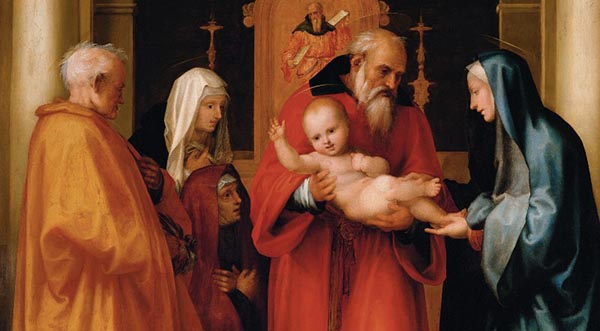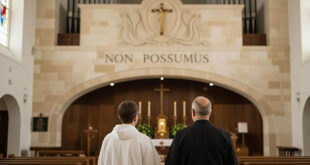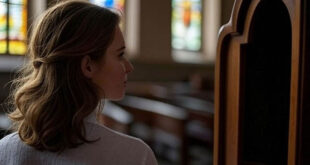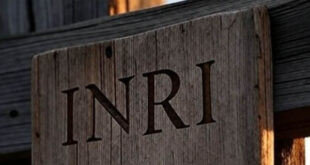The Presentation of Jesus in the Temple is one of the most profound moments in the Gospel, filled with symbolism, prophetic fulfillment, and spiritual teaching. It is celebrated on February 2nd in the Catholic Church as the Feast of the Presentation of the Lord, also known as the Feast of Candlemas. This solemnity invites us to reflect on total offering to God, spiritual purification, and Christ’s mission in the world.
Biblical Foundation: The Depth of a Rite
The account of the Presentation of Jesus is found in Luke 2:22-40. Mary and Joseph, obedient to the Law of Moses, take the Child Jesus to the temple in Jerusalem to fulfill two important precepts:
- The purification of the mother (Leviticus 12:2-8): According to the Law of Moses, after childbirth, a woman was considered impure for 40 days if she gave birth to a boy and 80 days if she gave birth to a girl. At the end of this period, she had to present an offering in the temple for her purification: a lamb and a turtledove or a pigeon. If she was poor, she could offer two turtledoves or two pigeons. Mary, in her humility, offered the offering of the poor, which shows the simplicity and poverty in which the Holy Family lived.
- The consecration of the firstborn (Exodus 13:2,12-15): Every firstborn male had to be presented to the Lord and “redeemed” through an offering. This rite recalled the liberation of the Israelites from Egypt when God spared the firstborn of the Hebrews. Although Jesus is the Son of God and does not need to be “redeemed,” His parents fulfill the Law with humility.
This seemingly ordinary act of Jewish life becomes a momentous event because, in the temple, they meet two key figures: Simeon and Anna, two elderly people full of faith, who recognize in the Child the coming of the Messiah.
Simeon and Anna: The Fulfillment of Hope
Simeon: The Prophecy of the Messiah and the Cross
Simeon is a righteous and devout man to whom the Holy Spirit had revealed that he would not die without seeing the Messiah. When Mary and Joseph arrive with Jesus, Simeon takes Him in his arms and proclaims a prophetic canticle, the Nunc dimittis (“Now, Lord, you may let your servant go in peace”, Luke 2:29-32).
This canticle is a universal proclamation of salvation: Jesus is “a light for revelation to the Gentiles and the glory of Israel.” It is the confirmation that Christ does not come only to save Israel but all nations.
Then, Simeon speaks prophetic words to Mary:
“This child is destined for the fall and rise of many in Israel and to be a sign that will be contradicted—so that the thoughts of many hearts may be revealed. And you yourself, a sword will pierce your soul” (Luke 2:34-35).
These words reveal that the Messiah’s path will not be one of earthly glory but of suffering and rejection. The “sword” that will pierce Mary’s soul is a foretelling of the sorrow she will experience as she witnesses her Son’s crucifixion.
Anna: The Prophetess of Faithfulness
Anna, an 84-year-old widow, served in the temple with fasting and prayers. Upon seeing Jesus, she praises God and speaks about the Child to all who await redemption. She represents the persevering faithfulness of those who trust in God throughout their lives.
Both Simeon and Anna teach us the importance of patience, hope, and continuous prayer.
Theological Significance: Christ, the Light of the World
The Presentation of Jesus in the Temple is not just an act of obedience to the Jewish Law but a moment of messianic revelation. This event highlights:
- Jesus as the Light of the Nations: He is the true light that enlightens everyone (John 8:12).
- The redemptive suffering: From His infancy, Jesus is destined for the cross.
- The obedience and humility of Mary and Joseph: Although they did not need purification or to redeem Jesus, they fulfill the Law to show us the value of obedience to God.
Practical Applications for Our Lives
1. Offering Ourselves to God
Just as Jesus was presented to God, we are also called to consecrate ourselves to Him. We can do this through prayer, the sacraments, and a life of faithfulness.
2. The Light of Christ in Our Lives
The Feast of the Presentation is also known as the Feast of Candlemas because, traditionally, candles are blessed, symbolizing Christ as light. This reminds us that we must carry the light of Christ into a world full of darkness by living with faith and hope.
3. The Patience and Prayer of Simeon and Anna
We live in an age of impatience, but Simeon and Anna teach us to trust in God’s timing. Prayer and faithfulness help us recognize the presence of Christ in our lives.
4. The Prophecy of the Cross in Our Lives
Suffering is part of the Christian life. Mary shows us that to accompany Christ means being willing to accept the cross with love. When we face difficulties, let us remember that the cross always leads to resurrection.
Conclusion: Presenting Our Lives to God
The Presentation of Jesus in the Temple calls us to consecrate ourselves to God with faith and humility. It invites us to be a light for others, to live with patience and hope, and to accept our cross with love. May we, like Mary, Joseph, Simeon, and Anna, recognize Christ in our lives and proclaim His light to the world.
Final Prayer
“Lord Jesus, Light of the Nations, enlighten our hearts so that we may recognize and follow You. Help us to present ourselves to You every day with humility and love. May we, like Mary and Joseph, be obedient to Your will, and like Simeon and Anna, wait for You with patience and hope. Amen.”






